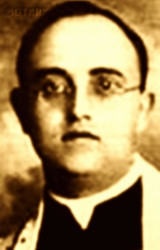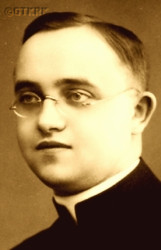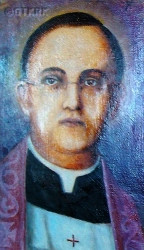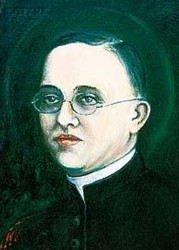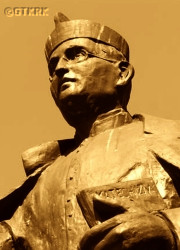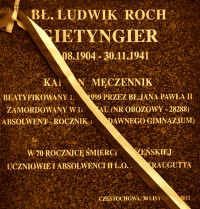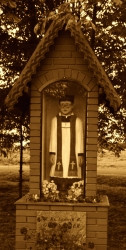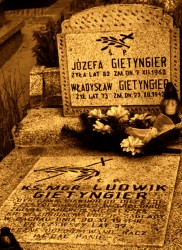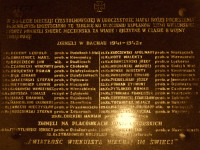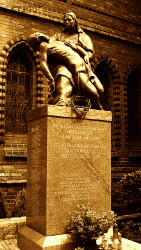Roman Catholic
St Sigismund parish
05-507 Słomczyn
85 Wiślana Str.
Konstancin deanery
Warsaw archdiocese, Poland
full list:
displayClick to display full list

searchClick to search full list by categories
wyświetlKliknij by wyświetlić pełną listę po polsku

szukajKliknij by przeszukać listę wg kategorii po polsku

Martyrology of the clergy — Poland
XX century (1914 – 1989)
personal data
religious status
blessed
surname
GIETYNGIER
forename(s)
Louis Rock (pl. Ludwik Roch)
beatification date
13.06.1999more on
www.swzygmunt.knc.pl
[access: 2013.05.19]

the RC Pope John Paul IImore on
en.wikipedia.org
[access: 2014.09.21]
function
diocesan priest
creed
Latin (Roman Catholic) Church RCmore on
en.wikipedia.org
[access: 2014.09.21]
diocese / province
Częstochowa diocesemore on
en.wikipedia.org
[access: 2013.05.19]
Kielce diocesemore on
www.diecezja.kielce.pl
[access: 2012.12.28]
academic distinctions
Theology MA
date and place
of death
30.11.1941

KL Dachauconcentration camp
today: Dachau, Upper Bavaria reg., Bavaria state, Germany
more on
en.wikipedia.org
[access: 2016.05.30]
details of death
After German invasion of Poland in 09.1939 and start of the World War II survived German air raid on Wieluń that flattened down 75% of the town.
Being unable to take over the director's post at the Bishop's Gymnasium in Wieluń due to closure of Polish secondary education by Germans nominated parish priest of Raczyn parish.
arrested by the Germans on 06.10.1941, as part of the action to eliminate the Polish Catholic clergy in the Germ. Reichsgau Wartheland province, established in the occupied Greater Poland region.
Interned in DL Konstantinow transit camp.
Finally on 30.10.1941 transported to KL Dachau concentration camp where perished beaten up to death by a German kapo.
According to the death certificate, prepared in KL Dachau, the „honest” otherwise German „medical doctors” and formalists — and at the same time, unrivaled fairy tale spinners — noted that the cause of death was Germ. „Versagen von Herz und Kreislauf, bei beiderseitiger Lungenentzündung” (Eng. „Heart and circulatory failure, due to bilateral pneumonia”).
prisoner camp's numbers
28288Click to display source page (KL DachauClick to display the description)
cause of death
extermination: exhaustion and starvation
perpetrators
Germans
sites and events
KL DachauClick to display the description, DL KonstantinowClick to display the description, 06.10.1941 arrests (Warthegau)Click to display the description, Reichsgau WarthelandClick to display the description, Air raids 1939Click to display the description, Ribbentrop‐MolotovClick to display the description, Pius XI's encyclicalsClick to display the description
date and place
of birth
16.08.1904

Żarkitoday: Żarki gm., Myszków pov., Silesia voiv., Poland
more on
en.wikipedia.org
[access: 2020.12.11]
parents
GIETYNGIER Vladislav
🞲 04.06.1870, ? — 🕆 23.12.1943, Żarkitoday: Żarki gm., Myszków pov., Silesia voiv., Poland
more on
en.wikipedia.org
[access: 2020.12.11]

MAŚLANKIEWICZ Josefa
🞲 10.03.1880, Żarkitoday: Żarki gm., Myszków pov., Silesia voiv., Poland
more on
en.wikipedia.org
[access: 2020.12.11] — 🕆 07.12.1962, Żarkitoday: Żarki gm., Myszków pov., Silesia voiv., Poland
more on
en.wikipedia.org
[access: 2020.12.11]
baptism
19.08.1904

Żarkitoday: Żarki gm., Myszków pov., Silesia voiv., Poland
more on
en.wikipedia.org
[access: 2020.12.11]
St Simon and St Judas Thaddaeus the Apostles RC church
presbyter (holy orders)
ordination
25.06.1927

Częstochowatoday: Częstochowa city pov., Silesia voiv., Poland
more on
en.wikipedia.org
[access: 2021.12.18]
Our Lady of Częstochowa RC chapelmore on
en.wikipedia.org
[access: 2017.01.21] (Jasna Góra i.e. Lat. Clarus Mons)
positions held
1939 – 1941
parish priest — Raczyntoday: Czarnożyły gm., Wieluń pov., Łódź voiv., Poland
more on
en.wikipedia.org
[access: 2021.12.18] ⋄ St Nicholas the Bishop and Confessor and St Tekla the Martyr RC parish ⋄ Wieluńtoday: Wieluń gm., Wieluń pov., Łódź voiv., Poland
more on
en.wikipedia.org
[access: 2021.07.18] RC deanery
1939
director — Wieluńtoday: Wieluń gm., Wieluń pov., Łódź voiv., Poland
more on
en.wikipedia.org
[access: 2021.07.18] ⋄ Thaddeus Kościuszko's Private Bishop's gymnasium for Men — appointee
1938
church assistant — Częstochowatoday: Częstochowa city pov., Silesia voiv., Poland
more on
en.wikipedia.org
[access: 2021.12.18] ⋄ Union of Catholic Intelligentsia Collective
1937 – 1939
PhD student — Krakówtoday: Kraków city pov., Lesser Poland voiv., Poland
more on
en.wikipedia.org
[access: 2021.06.07] ⋄ Jagiellonian University UJ
1934 – 1939
prefect — Częstochowatoday: Częstochowa city pov., Silesia voiv., Poland
more on
en.wikipedia.org
[access: 2021.12.18] ⋄ Holy Family RC cathedral parish ⋄ Częstochowatoday: Częstochowa city pov., Silesia voiv., Poland
more on
en.wikipedia.org
[access: 2021.12.18] RC deanery — Thaddeus Kościuszko's State Teachers Seminary for Men (1934‐1936), State Nursery Seminary (from c. 1937), State Vocational School (from 1934), Elementary School „Ćwiczeniówka” (c. 1937), Elementary School No. 3 (c. 1937), Primary School No. 4 (c. 1939)
1934 – 1939
chaplain — Częstochowatoday: Częstochowa city pov., Silesia voiv., Poland
more on
en.wikipedia.org
[access: 2021.12.18] ⋄ Congregation's house, Resurrectionist Sisters CR
1929 – 1934
prefect — Będzintoday: Będzin pov., Silesia voiv., Poland
more on
en.wikipedia.org
[access: 2020.12.11] ⋄ Holy Trinity RC parish ⋄ Będzintoday: Będzin pov., Silesia voiv., Poland
more on
en.wikipedia.org
[access: 2020.12.11] RC deanery — Wanda Replińska's Private Gymnasium for Girls, Public Elementary School No. 2 in Grodziec
1927 – 1929
vicar — Strzemieszycetoday: district of Strzemieszyce Wielkie in Dąbrowa Górnicza, Dąbrowa Górnicza city pov., Silesia voiv., Poland
more on
en.wikipedia.org
[access: 2020.12.11] ⋄ Sacred Heart of Jesus RC church ⋄ St Joseph Spouse of the Blessed Virgin Mary RC parish ⋄ Będzintoday: Będzin pov., Silesia voiv., Poland
more on
en.wikipedia.org
[access: 2020.12.11] RC deanery
1927 – 1929
student — Krakówtoday: Kraków city pov., Lesser Poland voiv., Poland
more on
en.wikipedia.org
[access: 2021.06.07] ⋄ theology, Department of Theology, Jagiellonian University UJ
1922 – 1927
student — Kielcetoday: Kielce city pov., Holy Cross voiv., Poland
more on
en.wikipedia.org
[access: 2021.06.07] ⋄ philosophy and theology, Theological Seminary
comments
The urn with ashes — cremation prob. took place in the crematorium at the Germ. Ostfriedhof (Eng. Eastern cemetery) in Munich — since 1950 has been kept at the Am Perlacher Forst cemetery, in a place known as Germ. Ehrenhain I (Eng. „Remembrance Grove No. 1”), in Munich. In 2013, information about the „disclosure” of the cremated remains of the KL Dachau victims made it to the front pages of news outlets. His urn bears the No. K1721.
sites and events
descriptions
KL Dachau: KL Dachau in German Bavaria, set up in 1933, became the main German Germ. Konzentrationslager (Eng. concentration camp) KL for Catholic priests and religious during World War II: On c. 09.11.1940, Reichsführer‐SS Heinrich Himmler, head of the SS, Gestapo and German police, as a result of the Vatican's intervention, decided to transfer all clergymen detained in various concentration camps to KL Dachau camp. The first major transports took place on 08.12.1940. In KL Dachau Germans held approx. 3,000 priests, including 1,800 Poles. The priests were forced to slave labor in the Germ. „Die Plantage” — the largest herb garden in Europe, managed by the genocidal SS, consisting of many greenhouses, laboratory buildings and arable land, where experiments with new natural medicines were conducted — for many hours, without breaks, without protective clothing, no food. They slaved in construction, e.g. of camp's crematorium. In the barracks ruled hunger, freezing cold in the winter and suffocating heat during the summer, especially acute in 1941‐1942. Prisoners suffered from bouts of illnesses, including tuberculosis. Many were victims of murderous „medical experiments” — in 11.1942 c. 20 were given phlegmon injections; in 07.1942 to 05.1944 c. 120 were used by for malaria experiments. More than 750 Polish clerics where murdered by the Germans, some brought to TA Hartheim euthanasia centre set up in Schloss Hartheim in Austria and murdered in gas chambers. At its peak KL Dachau concentration camps’ system had nearly 100 slave labour sub‐camps located throughout southern Germany and Austria. There were c. 32,000 documented deaths at the camp, and thousands perished without a trace. C. 10,000 of the 30,000 inmates were found sick at the time of liberation, on 29.04.1945, by the USA troops… (more on: www.kz-gedenkstaette-dachau.deClick to attempt to display webpage
[access: 2013.08.10], en.wikipedia.orgClick to attempt to display webpage
[access: 2016.05.30])
DL Konstantinow: Germ. Durchgangslager Konstantinow (Eng. Transit Camp) — resettlement concentration camp established on 05.01.1940 in Konstantynów Łódzki (c. 10 km west of the center of Łódź), and operational till 16.08.1943. Polish prisoners from Greater Poland (Wielkopolska), Pomerania and central Poland were held there. Approx. 42,000 were interned, thousands of them perished out of which approx. 700 were identified. In 10.1941‐12.1941 approx. 450 Polish priests and religious from Częstochowa, Łódź and Włocławek dioceses and Poznań archdiocese were imprisoned there prior to transport to KL Dachau concentration camp. (more on: pl.wikipedia.orgClick to attempt to display webpage
[access: 2013.08.10], ipn.gov.plClick to attempt to display webpage
[access: 2021.12.19])
06.10.1941 arrests (Warthegau): On 13.09.1941 Germ. Gauleiter (Eng. regional leader) of German province Germ. Reichsgau Wartheland (Eng. Wartheland Reich district), in German‐occupied Greater Poland (where German standard law was in force), Artur Greiser, implementing „Ohne Gott, ohne Religion, ohne Priesters und Sakramenten” — „without God, without religion, without priest and sacrament” — policy issued a decree formally dissolving Catholic Church and forming in its place a Roman Catholic German National Church in Germ. Warthegau, an organization subject to a German private law. The ordinance was issued backdated to 01.09.1939, i.e. the date of the German invasion of Poland, which sanctioned the later robbery of the property of the Catholic Church acting for the benefit of the Polish population by the Germans. All the contacts with Vatican were forbidden. All the religion congregations were also dissolved. Soon after, on 06‐07.10.1941, mass arrests of Polish Catholic priests took place — c. 352 were detained. All were herded into DL Konstantinow in Konstantynów or IL Lond in Ląd on Warta river transit camps or KL Posen concentration camp (in this case, the detainees were first registered, photographed and examined in the infamous Poznań headquarters of the German political police, the Gestapo, in the former Soldier's House). On 30.10.1941 most of them were transported to KL Dachau concentration camp.
Reichsgau Wartheland: After the Polish defeat in the 09.1939 campaign, which was the result of the Ribbentrop‐Molotov Pact and constituted the first stage of World War II, and the beginning of German occupation in part of Poland (in the other, eastern part of Poland, the Russian occupation began), the Germans divided the occupied Polish territory into five main regions (and a few smaller). The largest one was transformed into Germ. Generalgouvernement (Eng. General Governorate), intended exclusively for Poles and Jews and constituting part of the so‐called Germ. Großdeutschland (Eng. Greater Germany). Two were added to existing German provinces. From two other separate new provinces were created. Greater Poland region was one of them, incorporated into Germany on 08.10.1939, by decree of the German leader Adolf Hitler (formally came into force on 26.10.1939), and on 24.01.1940 transformed into the Germ. Reichsgau Wartheland province, in which the law of the German state was to apply. The main axis of the policy of the new province, the territory of which the Germans recognized as the Germ. „Ursprünglich Deutsche” (Eng. „natively German”), despite the fact that 90% of its inhabitants were Poles, was Germ. „Entpolonisierung” (Eng. „Depolonisation”), i.e. forced Germanization. C. 100,000 Poles were murdered as part of the Germ. „Intelligenzaktion”, i.e. extermination of Polish intelligentsia and ruling classes. C. 630,000 were forcibly resettled to the Germ. Generalgouvernement, and their place taken by the Germans brought from other areas occupied by Germany (e.g. the Baltic countries, Bessarabia, Bukovina, etc.). Poles were forced to sign the German nationality list, the Germ. Deutsche Volksliste DVL. As part of the policy of „Ohne Gott, ohne Religion, ohne Priesters und Sakramenten” (Eng. „No God, no religion, no priest or sacrament”) most Catholic priests were arrested and sent to concentration camps. All schools teaching in Polish, Polish libraries, theaters and museums were closed. Polish landed estates confiscated. To further reduce the number of the Polish population, Poles were sent to forced labor deep inside Germany, and the legal age of marriage for Poles was increased (25 for women, 28 for men). The German state office, Germ. Rasse‐ und Siedlungshauptamt (Eng. Main Office of Race and Settlement) RuSHA, under the majesty of German law, abducted several thousand children who met specific racial criteria from Polish families and subjected them to forced Germanization, handing them over to German families. After the end of hostilities of World War II, the overseer of this province, the Germ. Reichsstatthalter (Eng. Reich Governor) and the Germ. Gauleiter (Eng. district head) of the German National Socialist Party, Arthur Karl Greiser, was executed. (more on: en.wikipedia.orgClick to attempt to display webpage
[access: 2024.06.21])
Air raids 1939: During invasion of Poland commenced on 01.09.1939 Germans systematically attacked civilian targets. Many cities (Wieluń, Frampol, Warszawa, Lwów, Łomża, Puck, etc.) were bombed during air raids and totally destroyed. The hospitals and churches, visibly marked as such, were not spared. German planes also attacked columns of fleeing people on the roads, massacring them. It is estimated that c. 150,000‐200,000 civilians were killed or murdered by the Germans in 09.1939. (more on: en.wikipedia.orgClick to attempt to display webpage
[access: 2015.04.18])
Ribbentrop‐Molotov: Genocidal Russian‐German alliance pact between Russian leader Joseph Stalin and German leader Adolf Hitler signed on 23.08.1939 in Moscow by respective foreign ministers, Mr. Vyacheslav Molotov for Russia and Joachim von Ribbentrop for Germany. The pact sanctioned and was the direct cause of joint Russian and German invasion of Poland and the outbreak of the World War II in 09.1939. In a political sense, the pact was an attempt to restore the status quo ante before 1914, with one exception, namely the „commercial” exchange of the so‐called „Kingdom of Poland”, which in 1914 was part of the Russian Empire, fore Eastern Galicia (today's western Ukraine), in 1914 belonging to the Austro‐Hungarian Empire. Galicia, including Lviv, was to be taken over by the Russians, the „Kingdom of Poland” — under the name of the General Governorate — Germany. The resultant „war was one of the greatest calamities and dramas of humanity in history, for two atheistic and anti‐Christian ideologies — national and international socialism — rejected God and His fifth Decalogue commandment: Thou shall not kill!” (Abp Stanislav Gądecki, 01.09.2019). The decisions taken — backed up by the betrayal of the formal allies of Poland, France and Germany, which on 12.09.1939, at a joint conference in Abbeville, decided not to provide aid to attacked Poland and not to take military action against Germany (a clear breach of treaty obligations with Poland) — were on 28.09.1939 slightly altered and made more precise when a treaty on „German‐Russian boundaries and friendship” was agreed by the same murderous signatories. One of its findings was establishment of spheres of influence in Central and Eastern Europe and in consequence IV partition of Poland. In one of its secret annexes agreed, that: „the Signatories will not tolerate on its respective territories any Polish propaganda that affects the territory of the other Side. On their respective territories they will suppress all such propaganda and inform each other of the measures taken to accomplish it”. The agreements resulted in a series of meeting between two genocidal organization representing both sides — German Gestapo and Russian NKVD when coordination of efforts to exterminate Polish intelligentsia and Polish leading classes (in Germany called «Intelligenzaktion», in Russia took the form of Katyń massacres) where discussed. Resulted in deaths of hundreds of thousands of Polish intelligentsia, including thousands of priests presented here, and tens of millions of ordinary people,. The results of this Russian‐German pact lasted till 1989 and are still in evidence even today. (more on: en.wikipedia.orgClick to attempt to display webpage
[access: 2015.09.30])
Pius XI's encyclicals: Facing the creation of two totalitarian systems in Europe, which seemed to compete with each other, though there were more similarities than contradictions between them, Pope Pius XI issued in 03.1937 (within 5 days) two encyclicals. In the „Mit brennender Sorge” (Eng. „With Burning Concern”) published on 14.03.1938, condemned the national socialism prevailing in Germany. The Pope wrote: „Whoever, following the old Germanic‐pre‐Christian beliefs, puts various impersonal fate in the place of a personal God, denies the wisdom of God and Providence […], whoever exalts earthly values: race or nation, or state, or state system, representatives of state power or other fundamental values of human society, […] and makes them the highest standard of all values, including religious ones, and idolizes them, this one […] is far from true faith in God and from a worldview corresponding to such faith”. On 19.03.1937, published „Divini Redemptoris” (Eng. „Divine Redeemer”), in which criticized Russian communism, dialectical materialism and the class struggle theory. The Pope wrote: „Communism deprives man of freedom, and therefore the spiritual basis of all life norms. It deprives the human person of all his dignity and any moral support with which he could resist the onslaught of blind passions […] This is the new gospel that Bolshevik and godless communism preaches as a message of salvation and redemption of humanity”… Pius XI demanded that the established human law be subjected to the natural law of God , recommended the implementation of the ideal of a Christian state and society, and called on Catholics to resist. Two years later, National Socialist Germany and Communist Russia came together and started World War II. (more on: www.vatican.vaClick to attempt to display webpage
[access: 2023.05.28], www.vatican.vaClick to attempt to display webpage
[access: 2023.05.28])
sources
personal:
pl.wikipedia.orgClick to attempt to display webpage
[access: 2014.12.20], www.ipgs.usClick to attempt to display webpage
[access: 2012.11.23]
bibliographical:
„Urns kept at the Am Perlacher Forst cemetery — analysis”, Mr Gregory Wróbel, curator of the Museum of Independence Traditions in Łódź, private correspondence, 25.05.2020
„Schematismus Universi Venerabilis Cleri Saecularis et Regularis Dioecesis CzęstochoviensisClick to display source page”, Częstochowa diocesa Curia, 1926‐1939, diocesan printing house
„International Tracing Service (ITS), Bad Arolsen, GermanyClick to display source page”, Arolsen Archives
original images:
www.swietyjozef.kalisz.plClick to attempt to display webpage
[access: 2017.01.21], powiat.bedzin.plClick to attempt to display webpage
[access: 2017.01.21], edukacja.ipn.gov.plClick to attempt to display webpage
[access: 2024.01.21], archiczest.plClick to attempt to display webpage
[access: 2016.08.14], www.sosnowiecfakty.plClick to attempt to display webpage
[access: 2017.01.21], www.pomnikowo.euClick to attempt to display webpage
[access: 2017.01.21], www.wczestochowie.plClick to attempt to display webpage
[access: 2013.12.04], www.polskaniezwykla.plClick to attempt to display webpage
[access: 2017.01.21], www.genealogia.okiem.plClick to attempt to display webpage
[access: 2017.01.21], www.basiapg.republika.plClick to attempt to display webpage
[access: 2014.01.06], www.szczecin.plClick to attempt to display webpage
[access: 2014.09.21]
LETTER to CUSTODIAN/ADMINISTRATOR
If you have an Email client on your communicator/computer — such as Mozilla Thunderbird, Windows Mail or Microsoft Outlook, described at WikipediaPatrz:
en.wikipedia.org, among others — try the link below, please:
LETTER to CUSTODIAN/ADMINISTRATORClick and try to call your own Email client
If however you do not run such a client or the above link is not active please send an email to the Custodian/Administrator using your account — in your customary email/correspondence engine — at the following address:

giving the following as the subject:
MARTYROLOGY: GIETYNGIER Louis Rock
To return to the biography press below:
 Click to return to biography
Click to return to biography








